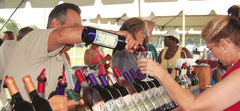 It’s easy to get impatient as you begin the journey to wine knowledge and enjoyment. Progress is slow — a glass here, a bottle there.
It’s easy to get impatient as you begin the journey to wine knowledge and enjoyment. Progress is slow — a glass here, a bottle there.
But sometimes-wine enthusiasts get a chance to progress by leaps and bounds instead of the baby steps of a taste here and a taste there. Local, Regional or National Wine festivals provide the opportunity to expand your horizons. Responsibly navigating your way through those hundreds of wine choices, however, takes patience and strategy.
WHAT TO EXPECT
As with any large, public event, wine festivals will give you a great opportunity to socialize and compare notes with other wine enthusiasts. Yes, you’ll taste wines, and lots of them, but you’ll also explore the world of wine.
Books have been written on how to develop professional tasting skills, but remember that the goal of your evening is not to judge the wines for the commercial wine trade, but for your own personal discovery and enjoyment. Your goal? Walking away with a heightened appreciation of the wonderful world of wine … and, of course, a list of some new favorites.
DISCOVERING THE WINES
Whether in the privacy of your home, a restaurant in Paris or at the next wine festival, you want to remember the wines you taste. Think of and classify them by color, aromas and taste. No need for fancy terms or the latest wine vocabulary. Keep it simple.
Look at the wine for color. If you thought wine was only red or white, take a closer look to discover the pinks, golden yellows, green tints, purple or even black colors that fill your glass.
Smell the wines for familiar aromas. Take the glass by the stem and give it a swirl to maximize the aromas. Don’t feel awkward placing your nose deeply into the glass to detect the aromas. You may smell simple fruits, smoke, citrus or even your grandmother’s rose perfume. It is the aroma that will help you remember what you enjoyed about the wine, grape or country of origin. (If you find the entire concept of swirling, smelling and tipping the glass a bit intimidating, practice at home with your wine at dinner or even water in a wine glass over the kitchen sink.) And finally— the moment you are waiting for and the reason to attend the event— taste. Swirl the wine in your mouth. Does it feel heavy or light? Does it taste sweet (like sugar on the tip of your tongue) or dry (complete lack of sweetness)? Does the wine have strong tannin or subtle tannin (a drying effect on the gums and sides of the mouth)? Think of the incredible taste descriptors as it fills your palate. It may be strawberry, lemon, nuts, berries, tobacco or even licorice.
Stay with these simple tips and you will discover wines that range from easy drinking to complex masterpieces, and remember, it’s only your personal enjoyment of the wine that matters.
TASTING BY CATEGORY
If the thought of having hundreds of wines at your fingertips is an overwhelming concept, try tasting them in groups. Easy methods include: By countries: Australia, Spain, Chile, Germany, etc.
By regions in big wine-producing countries: For France, Burgundy, Bordeaux or the Rhone Valley; in California sample wines from the Central Valley, Napa and Sonoma.
By grape varieties: cabernet sauvignon, chardonnay, sauvignon blanc, merlot or pinot noir.
This way of navigating big wine events lets you compare and contrast large amounts of wines you may not have had the opportunity to taste in one setting.
TAKE NOTES
Most tasting events offer listings of wines and ample room for jotting down notes. Take advantage of the note-taking to remember these wines after the event has ended. You can organize thoughts according to color, aroma and taste, or use a simple technique called “scribble” — stars, smiley faces, “best value”, “try with fish from Susan’s recipe” or even “great gift idea for Aunt June next Christmas.” The good news is that only you will be reviewing these wine notes later at home, so no need to focus on fancy details.
SPIT AND SPIT OFTEN
The last and possibly most important tip for large tasting events is acknowledging that the key word is “tasting” not “drinking.” If you plan on trying a large number of wines, you will definitely want to become well acquainted with the spittoon. Remember: Spitting is part of the tasting process and not a social faux pas. A responsible tasting atmosphere will only offer a quarter-glass pour. Don’t be offended by the amount of the pour or even feel embarrassed to dispose of excess wine into spittoons. It is all part of the tasting atmosphere, so you can have the fullest enjoyment of the evening.
TAKE ADVANTAGE
Remember, if you love wine, wine festivals supply a rare and incredible opportunity to sample a lot and learn a lot in a short time. To replicate the experience on your own would take hundreds of days and hundreds of dollars.
And you don’t even have to feel guilty for spending the modest amount of money required to get a ticket — it goes to a great cause.